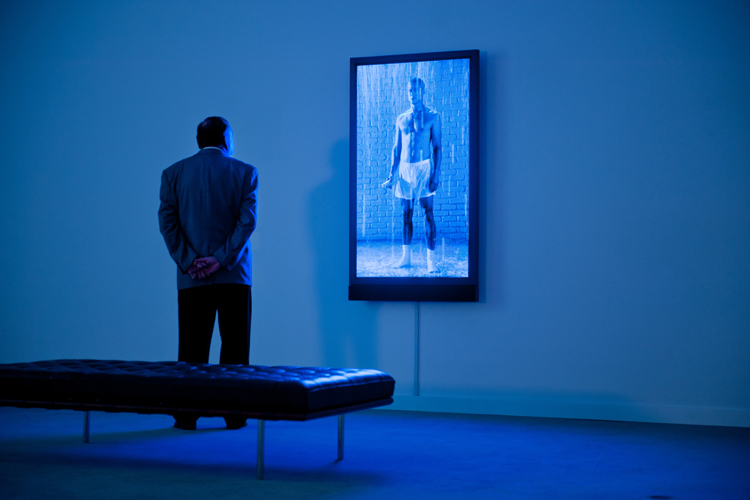VIDEO PRODUCTION, INTERNATIONAL ART EXHIBITION, BROADCAST, PUBLICATION

The only way to truly experience theater is to be physically on one side of the proscenium or the other, or be a part of the more participatory theater where the proscenium has been dispensed with all-together. If these statements are true then what kind of legacy does a theater artist leave for future audiences? Video, film and photography are offered as documents of a performance but rarely come close to the three dimensional experience; the sounds as they radiate through the theater, lighting as it wraps around a hand, the anticipation of the audience, the subtle gesture of the individual actor.
Robert Wilson is one of the rare artists who works across artistic media without being buoyed by one method of making. The process of creation transcends a single medium and instead finds outlet within the archetype of an opera, the architecture of a building, the stains in a watercolor drawing, the design of a chair, the choreography of a dance, the rhythm of a sonnet, or the multiple dynamics revealed in a Video Portrait.
By incorporating a multitude of creative elements; lighting, costume, make up, choreography, gesture, text, voice, set design, and narrative – the video portraits act as a complete synthesis of all the media in the realm of Wilson’s art making. The canvas or High Definition (HD) screen is one thing, blending the environmental and spatial aspects of a stage with a new sensibility for Wilson’s direction. The medium is HD video but the form blurs time-based cinematography with the frozen moment of still photography. As in the layering nature of Wilson’s creative process, the video portraits infuse references found in painting, sculpture, design, architecture, dance, theater, photography, television, film and contemporary culture. The final result on the HD monitor resembles a photograph, but on closer inspection reveals Wilson’s highly developed theatrical language in conjunction with the startling clarity and precision of HD video.
The video portrait of Princess Caroline of Monaco is an apt example of how cultural histories, images and a host of ideas are incorporated to construct a single portrait. The starting point for this portrait was her mother Grace Kelly and her character Lisa Fremont from the 1954 Alfred Hitchcock classic Rear Window. A pivotal moment in the film occurs when Lisa, discovering a substantial clue to a murder in the form of a missing wedding ring, signals that fact to her boyfriend photographer/voyeur L.B. "Jeff" Jeffries played by Jimmy Stewart. The lost ring as a sign of the love lost between husband and wife, and in this case murder, while at the same time a sign of the future bond between Lisa and Jeff is pure Hitchcock. Wilson’s appropriation of this gesture and the synthesis with John Singer Sargent’s Madame X, who as a society woman also has reflections in the Lisa Fremont character, and her eternal gesture bring together two forms of art and history in a powerful way. The unfolding lighting sequences on the hands/ring, the upper arm and face or just the black silhouette seem at one and the same time classical and tribal, vacillating between a portrait and landscape, reflecting both Sargent and Hitchcock. With the Bernard Hermann sound score from Vertigo the final result is seminal Wilson.
The overwhelming positive response to the exhibition is owed to portraits captivating originality but also to the more populist nature the exhibition exudes – the child can experience a portrait just as thoughtfully as the academic, the patient can take away just as much as the impatient. It is also worth considering Andy Warhol’s statement "If it moves, they’ll watch it", a comment on the reptilian brain, which is why the moving image has extreme power in today’s society – try sitting in a room with a television playing in the background and not be drawn to it. Although Warhol’s statement is a compelling thought, people seem to be drawn to Wilson’s Video Portraits because they kindle imagination and curiosity, and this is what transcends age, race, education, politics, and the like differences. Given Wilson’s work across a multitude of media, the Video Portraits have turned into a defining project because it embodies all of Wilson’s artistic languages in a timeless medium that can be experienced equally today, as they will be tomorrow.
— Noah Khoshbin & Matthew Shattuck
